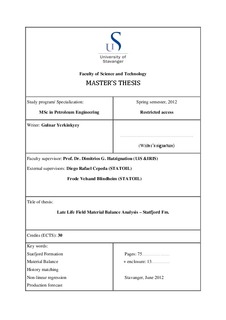Late life field material balance analysis – Statfjord Fm.
Master thesis
Permanent lenke
http://hdl.handle.net/11250/183624Utgivelsesdato
2012Metadata
Vis full innførselSamlinger
Originalversjon
Conf. until june 2014Sammendrag
Recently, it has become apparent that the prediction of the Statfjord reservoir potential determined from the ECLIPSE simulator differs from the actual formation performance, i.e. simulated fluid production results are too optimistic, especially for the gas phase. Since the validity of the Statfjord ECLIPSE model is considered questionable, the alternative approach of material balance is employed to evaluate the possibility of using simplified models (MBAL) to assess the dynamic reservoir performance.
It is well established that the material balance methodology is a zero dimensional model much simpler compared to reservoir simulation one (e.g. ECLIPSE model). Despite the simplicity of the material balance technique, it can develop a consistent understanding of the reservoir. It is believed that for the model in order to reproduce the actual reservoir behavior the reservoir understanding plays important role rather than the degree of complexity with which it was constructed.
Prior to modeling the Statfjord formation, a quality review was done to the entire production/injection history, pressure depletion behavior and drainage strategy in order to broaden the knowledge regarding the reason of the experienced simulation/actual data mismatch.
A sensitivity analysis based on the history matching procedure was conducted in terms of the matching variables choice, such as fluid migration and aquifer influence, and the uncertainty surrounding them. In the history matching process, a combination of the analytical non-linear regression and manual history matching methods were used to mimic the actual average reservoir behavior. Following the history matching procedure, the STOIIP and aquifer influx determined from MBAL were crosschecked with the ECLIPSE simulator’s results. The comparison indicated that the MBAL and ECLIPSE values for these two variables were very close.
Once a representative MBAL model was established, the average reservoir pressure and gas production were forecasted until the field’s abandonment pressure. The MBAL gas production forecast was lower to the one obtained from the ECLIPSE reservoir simulator. The comparison of the average reservoir pressure depletion between ECLIPSE and MBAL yielded acceptable results.
Summarizing, this thesis presents the application of the MBAL tool for the Statfjord formation to quantify the remaining reserves and reservoir pressure depletion performance.
Beskrivelse
Master's thesis in Petroleum engineering
